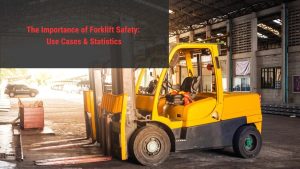
Forklifts, while instrumental in moving heavy loads over short distances, can become hazards if not operated with the utmost care and precision. The potential for accidents ranges from collisions and tip-overs to pedestrian incidents, each carrying the risk of severe injury or even fatality. Recognizing this, businesses have increasingly focused on enhancing forklift safety measures. These efforts aim to protect employees and minimize the economic repercussions associated with workplace accidents, such as lost productivity, medical costs, and legal liabilities.
This article, supported by use cases and statistics, highlights the critical role of forklift safety in preventing accidents and fostering a safer workplace.
The Critical Nature of Forklift Safety
The statistics surrounding forklift accidents are sobering.
According to reports from the Occupational Safety and Health Administration (OSHA), forklift accidents account for approximately 85 fatal accidents annually. Forklift incidents contribute to about 34,900 serious injuries and 61,800 non-serious injuries annually in the United States alone.
These numbers highlight the critical need for stringent safety protocols and training programs to mitigate the risks associated with forklift operations.
Use Cases Demonstrating the Impact of Safety Measures
Several use cases underscore the effectiveness of comprehensive forklift safety programs.
For instance, a large distribution center implemented safety measures, including operator training, regular equipment inspections, and installing safety technologies such as anti-collision sensors and automatic speed limiters. Within a year, the facility reported a 70% reduction in forklift-related accidents, demonstrating the tangible benefits of a dedicated safety approach.
Another example involves a manufacturing plant that introduced a safety-first culture by engaging employees in safety workshops, encouraging the reporting of near misses, and enforcing strict adherence to safety protocols. This initiative significantly decreased incident rates and increased employee morale, as workers felt more valued and safe in their environment.
The Role of Training and Technology in Enhancing Safety
Effective forklift safety programs hinge on two pillars: comprehensive operator training and the integration of advanced safety technologies.
Operator training provides those behind the wheel are well-versed in safety practices, equipment handling, and hazard recognition. This education equips operators with the knowledge and skills to navigate potential dangers and react appropriately in critical situations.
On the technological front, innovations such as telemetry systems, which provide real-time monitoring of forklift operations, and wearable devices that alert pedestrians to approaching forklifts have revolutionized safety protocols. These technologies complement traditional safety measures, offering an additional layer of protection and further reducing the likelihood of accidents.
The Economic and Human Impact of Forklift Safety
The implementation of forklift safety measures has profound economic and human impacts. From a financial perspective, companies prioritizing forklift safety can see reduced costs associated with accidents, including medical expenses, equipment damage, and potential litigation. Moreover, maintaining a safe workplace enhances operational efficiency, as fewer accidents mean less downtime and a more stable workflow.
On a human level, the importance of forklift safety transcends mere statistics. Behind every accident is an individual whose life may be forever changed by an injury. By prioritizing safety, businesses comply with legal obligations and are committed to their employees’ well-being. This commitment fosters a positive workplace culture, where safety is ingrained in every task, and employees feel valued and protected.
Moving Forward: The Path to Safer Forklift Operations
The journey toward safer forklift operations requires ongoing commitment and adaptation. As technology advances and workplaces evolve, so too must safety protocols. Companies should continually assess their safety practices, seek employee feedback, and stay abreast of new safety technologies and methodologies. Engaging in a continuous evaluation, implementation, and improvement cycle is essential for sustaining a culture of forklift safety.
The statistics paint a clear picture of the potential risks, but these risks can be substantially mitigated through diligent efforts and technologies offered by Trio Mobil. Use cases across industries demonstrate the effectiveness of safety measures, highlighting the dual benefits of protecting employees and safeguarding the bottom line. By investing in training, technology, and a culture of safety, businesses can navigate the challenges of forklift operations, providing a safer and more productive workplace for all.

